A Thing of Beauty _|_ Issue 17, 2021
A Thing of Beauty: The House of the Virgin Mary in Ephesus
Artist Simon Blackwood recalls his trips to Turkey in the 1970s, and shares some of his paintings of the places he visited
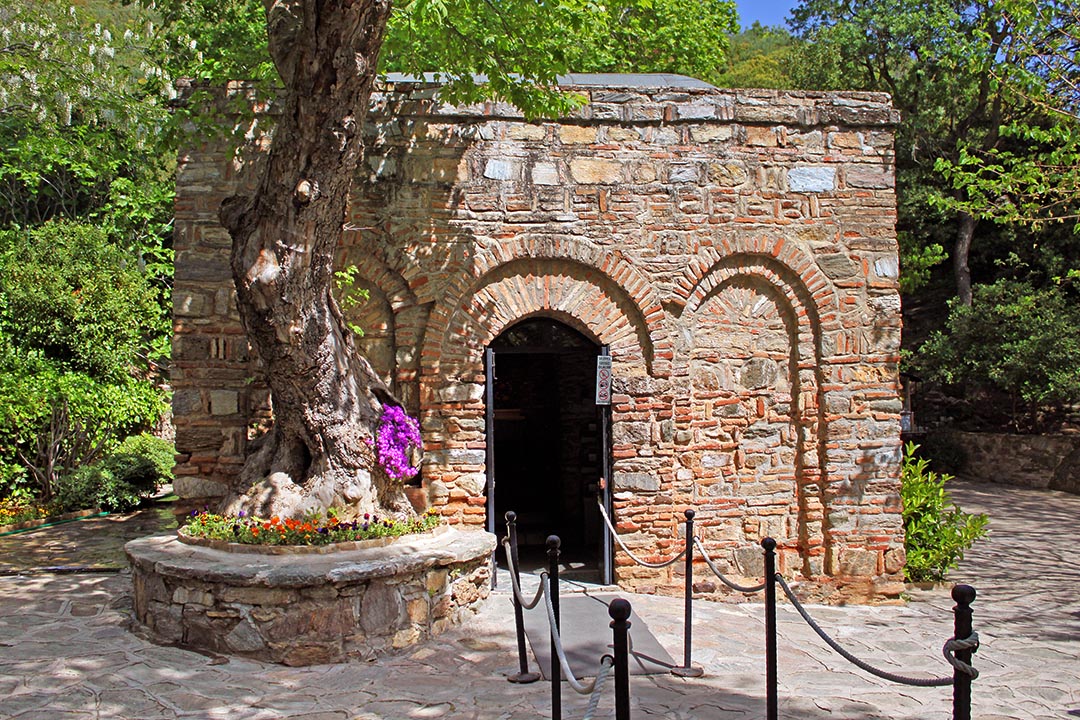

A Thing of Beauty: The House of the Virgin Mary in Ephesus
Artist Simon Blackwood recalls his trips to Turkey in the 1970s with the Beshara School, and shares some of his paintings
Artist Simon Blackwood remembers his visits to the house of the Virgin Mary, where she is thought to have spent the last years of her life in the tranquil mountains above the Roman city of Ephesus on the West coast of Turkey. The article is also a remembrance of the ‘Turkey trips’ of the 1970s during which Simon first visited the house. These were journeys of discovery undertaken annually by students of the Beshara School which included visits to some of the great spiritual presences of the Ottoman tradition and culminated in Konya for the celebrations of the ‘Nuptial Night’ of Jalaluddin Rumi. At the end, we present some of Simon’s paintings inspired by the places he mentions.
Meryam Anna Evi (Mary’s House) is situated near Ephesus in South-western Turkey, close to Seljuk and Izmir. The tiny stone house sits in a secluded spot on Mount Koressos, or Bulbuldag in Turkish, which means ‘Mount of the Nightingales’. I remember visiting it once in the summer months; as we walked up the hill, the heat on the dry soil and stones seemed to carry with its convection the luscious smell of burgeoning fig leaves and the scorched olive branches’ camphor-like well-being. A word came to mind – tranquility. Mary always represents this quality to me, where the only lack, if there is one, is of tension.
The house was discovered in the 19th century following a series of revelations that appeared to Anne Catherine Emmerich (1774–1824) a Catholic nun, who never visited Turkey. Her visions were related in a book by her secretary Clemens Brentano, The Dolorous Passion of Our Lord Jesus Christ (published 1833) (1), and this eventually led to the uncovering of the house by a French priest, Abbé Julien Gouyet, during 1881. The story is that Mary was brought to Ephesus by St John – into whose care she had been entrusted by Jesus on the cross (2) – and she spent her last years in this peaceful spot. There has been much controversy about the authenticity of the site, particularly as many stories emanating from Brentano’s account were later shown to be highly embellished, and it has never formally been recognised by the Catholic Church – although it has been blessed with two papal visits, by Popes John Paul II and Benedict XVI.
Nevertheless, both Christians and Muslims have rendered Meryam Anna Evi a place of pilgrimage, and it was for the honouring of Mary that we went there. Muslims visit because Mary is revered within Islam as the mother of the prophet Jesus, and, with a chapter named after her, is honoured as one of only three women mentioned by name in the Qur’an. The house that stands on the site now is by no means of the period during which Mary would have spent the last days of her life. But a small ‘baptismal’ pool close by has been dated back to the Apostolic age, when possibly an early community of Christians lived here, in order to escape the Romans and whatever persecutions they might have otherwise suffered. Some recent carbon dating seems to reveal that the original site may well have been at the time Mary and John would have lived. But the twists and turns of ‘proof’ of age or authenticity have never even occurred to me whenever I have visited the house over the past 45 years. When you willingly accept a presence you somehow become a part of its reality, and in this instance Mary’s compassion is palpable.
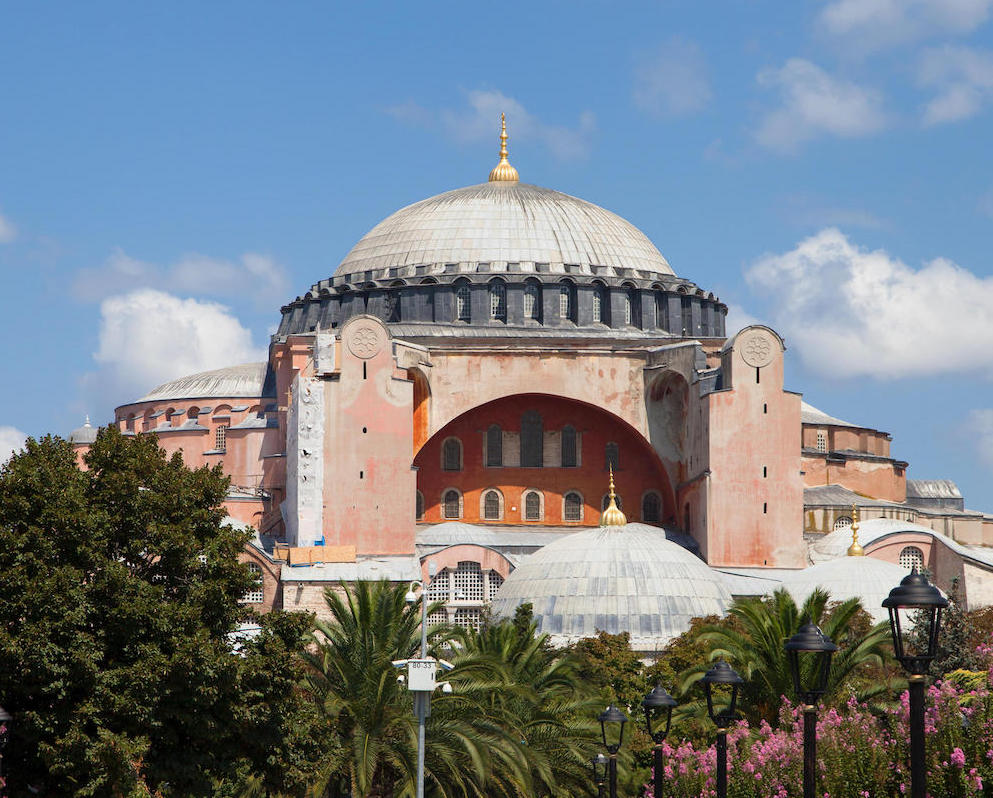
The Turkey Trip
(For m.
My first trip to the house took place in the 1970s as part of a trip organised by the then newly-founded Beshara School of Intensive Esoteric Education. Each year between 1975 and 2016, the students went on the ‘Turkey Trip’ in December, midway through their six months residential course. These courses were set up to be a time of searching for ‘the real meaning of life’, ‘why are we here?’, and on the back of a new impetus emerging in the young, championed by the events of 1968, the Beatles, etc. A spiritual hotbed of teachers had appeared in the West as if out of nowhere, but actually from the East, Middle East and Near East, beckoning us towards a bright future.
The trip was born partly out of the Beshara students’ introduction to the great spiritual masters of the Turkish tradition. Texts by such erudite authors as the Arabic philosopher/mystic Muhyiddin Ibn ʿArabi and the Persian poet/mystic Jalaluddin Rumi were just becoming available for study in English translation and played a significant role in the curriculum, alongside studies in Christianity, Judaism, Hinduism, Zoroastrianism and Buddhism. (For more on these and current Beshara courses, see the Beshara Trust website.) One of the aims was to put the teachings into a physical context, courtesy of Bulent Rauf, who was advisor to the Beshara Trust until his death in 1987. The trip was timed to coincide with the ‘Semā’ in Konya – the celebration of ‘Rumi’s Night’ on the 17th December, recognised as the day of Rumi’s death in 1273CE.
Ali Muhammed Bulent Rauf, whose family was in the court of the last Sultans of the Ottoman Empire in Turkey, was by profession an archaeologist. As such, he was able to draw out parallels between the Sufi traditions and the changing nature of human life through the wealth of archaeological sites from Greek and Roman times evident in that richly diverse country. As the trip developed over the years, it took in many aspects of Anatolian history and archaeology: at Iznik, the remains of the monastery where the Nicene Creed was formulated; along the western sea coast, the great Graeco-Roman cities of Miletus, Pergamon and Ephesus; in Cappadocia, the extraordinary dwellings at Göreme. It matured into a real voyage of discovery for all who were able to take part. And in the early days at least, there were many of us; on one trip there were 120 people, requiring three coaches to carry us on our journey of some 2000 miles.

Istanbul: view over the Rustem Pasha mosque to Eminonu harbour, where ferries leave for the Asian side. Photograph: Ayhan Altun [/] / Alamy Stock Photo
Istanbul
.
The itinerary was action packed, starting in Istanbul for a couple of nights in Pera, at the Pera Palace Hotel in the days when, before its refurbishment, it was cheap and accessible. There the students made the first of many visits to Turkish saints who had influence upon the development of Sufi tradition – people who exemplified devotion and humility, and often contributed to the breadth of knowledge of the time through their writings and commentaries. These men were also of great significance to the local communities where they had lived and worked; until the 20th century, there were no organised schools of learning other than by virtue of the mosque or the local tekke centred around a shaykh, where devotees would learn to read and write and become imbued with the sentiment of the central texts by memorising them through repetition, sometimes from an early age. As in many monastic traditions, the Sufi tekkes offered security, advice, and counsel to all who entered, regardless of creed or nationality.
The first visit was from Eminonu across the Bosphorus to the Asian side by vapur (Istanbul’s ferry boats, originally built in Glasgow) to the ‘village’ of Uskudar. The tomb of Aziz Mahmud Hudayi Efendi (1541–1628), known as the Sun of the Jelveti Sufi Order, spiritual advisor to eight Ottoman Sultans, sits on the side of a hill above the jetty. It has a very fine entrance porch and vestibule of wrought iron and glass which Bulent Rauf’s grandmother had inaugurated, from which the viewer can look out across the dominion of the saint’s influence during his lifetime.
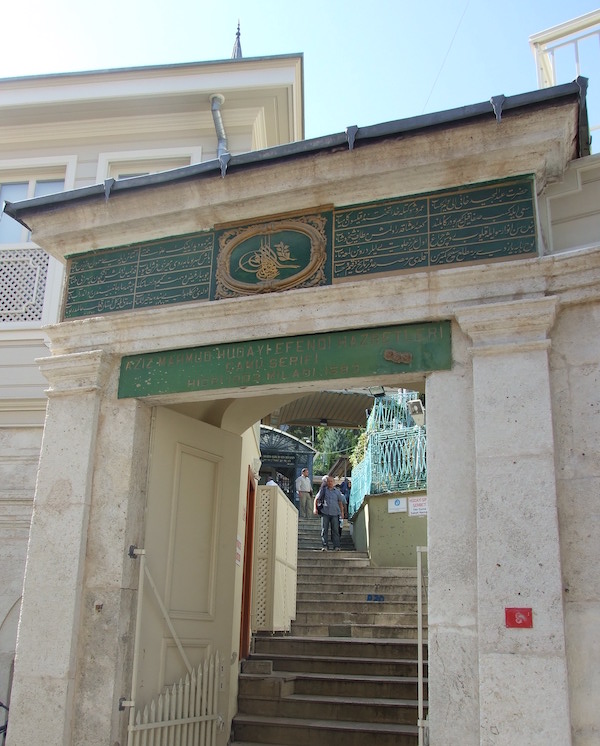
The tomb of Aziz Mahmud Hudayi in Uskudar, Turkey. Photograph: Richard Twinch
These days the tombs of saints in Turkey are packed with visitors, but during the middle period of the 20th century all dervish orders were banned by Kemal Ataturk as part of his modernisation programme. So these shrines were only allowed to continue ‘as if’ they were museums. The result was that they were often closed, and each visit began by finding the muezzin from the nearby mosque who would then locate the person with the key to allow us in. The dervish order that developed after Hudayi had a fine kitchen where, by tradition, food was provided locally for the poor and needy. It would be a few more years before this was reinstated after the ban was eased towards the end of the century and the museums were once more attended by visitors and local devotees alike. In the meantime at the tomb, visitors, although rare, were offered sugar lumps on leaving as a symbol of the sweetness that the saint represented.

View over the domes of the Great Mosque in Bursa, Turkey. Photograph: Muharremz/iStock
Bursa
.
After a short time in Istanbul, the journey continued through some of the most productive vegetable growing areas of the Aegean Coast before reaching Bursa, the old Ottoman capital prior to the conquest of Constantinople in 1453. This remained an important centre of spirituality until the 20th century. Here we stayed at the then-luxurious Celik Palas Otel with its hugely long, winding corridors, sumptuous cotton towelling dressing gowns and the ‘Iron Baths’ famously fed from springs flowing through the larval heating beneath Mount Uludag (Big Mountain). Everyone was encouraged to visit the hamam to sip cooling ayran (slightly salted yoghurt and milk) after having been heated and cleansed in the beautiful domed pool. The ceiling was perforated with small star-shaped windows which, when the sunlight burst through, created a mystical and utterly romantic Ottoman atmosphere.
In Bursa students visited some of the great figures of the Ottoman Sufi tradition, beginning with Hazreti Uftade (1490–1580), the teacher of Hudayi, whose tomb overlooks the Great Mosque. They could also, if they wished, negotiate the steep streets to his house and retreat cell higher up the mountain. Before it burnt down and was rebuilt, the old wooden building was still inhabited and maintained by his descendants.
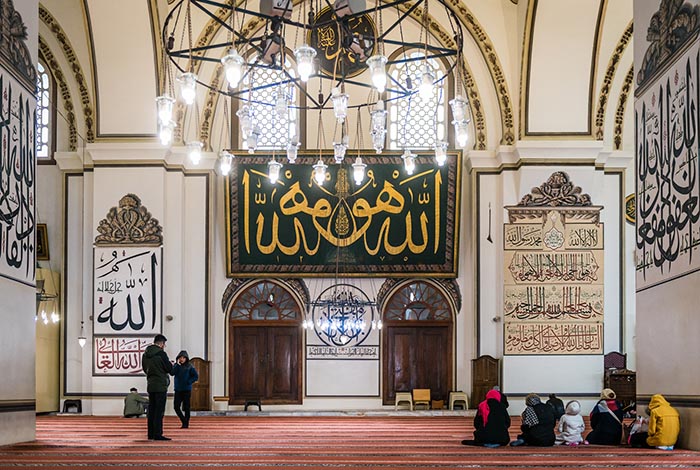
Interior of the Great Mosque in Bursa, built by the Ottoman Sultan Beyazid 1 in 1369–99. Bursa was the capital of the Ottoman Empire before the conquest of Istanbul. Photograph: alvita/iStock
There were also visits to the Jelveti shaykh, Ishmael Hakki Bursevi (1652–1725), in the centre of the town, and to the beautifully decorated Green Mosque, followed by lunch at Iskender Lokantasi, famous for the Kebab invented by its founder. This is made of lamb doner sliced onto fresh pide bread with a generous helping of tomatoes and onions fried in local olive oil, topped with a superb, unpasteurised, creamy yoghurt. This was near the Silk Bazaar, and afterwards the students were let loose to enjoy all that Bursa had to offer in those halcyon days before mass tourism and intense air pollution – delights such as mulberries both black and white, and fabulous fabrics and kelims the like of which, at that time, were entirely new to the Western visitor.
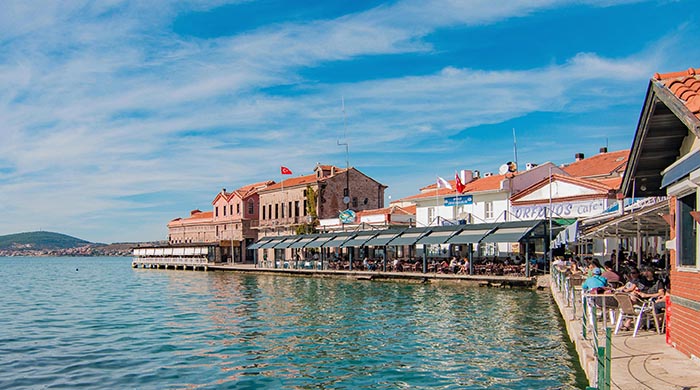
Ayvalik old harbour on the West coast, overlooking the Aegean Sea; a lunchtime stopover on the journey from Bursa to Ismir. Photograph: Leks Agency [/] / Alamy Stock Photo
The West Coast Cities and Ephesus.
Another four- or five-hour journey took us on to Ayvalik where all the best olives used to be found and where the course kitchen would stock up with bags of freshly harvested fruit and olive oil. The town is on the west sea coast, facing the Aegean, and had some simple lokantasi on the sea front. The sudden influx of a large number of needy Westerners was sometimes a stretch for the resources of restaurant owners out of season. But, with typical Turkish ingenuity and hospitality, they always rose to the demand with deliciously simple and fresh food. No one goes without food in Turkey.
Then a visit to the nearby ancient site of Pergamon, which in the first century BCE had a library second only to that of Alexandria. One can still visit the remains of the Asklepion, an ancient healing complex with mineral springs that later revealed radioactive properties, which was the first psychiatric hospital. There can be seen atmospheric underground stone tunnels occasionally pierced by overhead holes in the stonework, through which the patients below were attended by physicians who listened to their recounting dreams and probably also made interjections upon the tranquillity during the night with their own suggested agenda. It was in this place that the great Roman physician Galen (130–210CE), whose theories dominated European medicine for 1500 years, was born and educated.
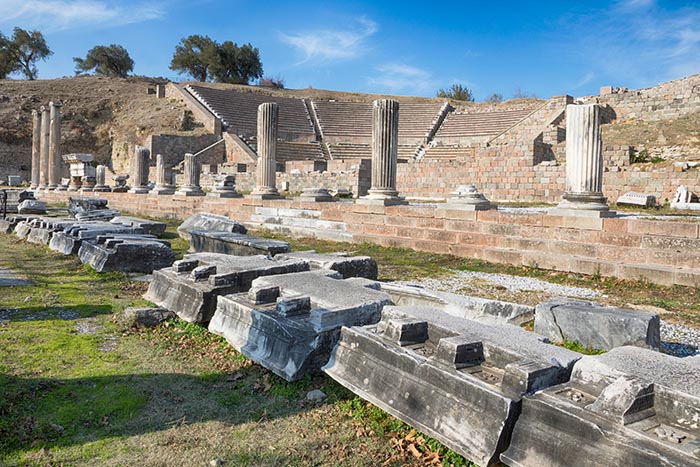
The Asklepion, or healing centre, at Pergamon, Turkey, dating from at least the first century CE. There were facilities for treating mental illness as well as physical, including an amphitheatre where tragedies were performed to bring about catharsis. Photograph: tunart/iStock
Next came Izmir, overnight, and the day after, Seljuk, where we made the visit both to Meryam Anna Evi and the great city of Ephesus. Seljuk in the 1970s was a tiny village with one taxi driver and one, very basic, hotel. That taxi driver once regaled us with stories of how a group of Americans and Germans had come the previous year to smuggle away sarcophagi from Ephesus in pieces to avoid customs duty. Ephesus was a ruin for centuries and had last been excavated by Austrian archaeologists in the 1950s. It has since been gradually touristified by the Turks, with imagination if not accuracy of restoration, but in the 1970s it had atmosphere and the openness of the ravages of time, leaving its beauty to the imagination of the visitor as well as the archaeologists.
The students, however, always went straight on to Mary’s House, as this was in some ways the focus of the whole trip. Beshara is an Aramaic word meaning ‘good news’ or ‘omen of joy’, and in both the Hebrew Bible and the Qur’an it is associated with the Annunciation, when Angel Gabriel blew into Mary the breath of the spirit. At the level of meaning, she represents the completely receptive place in which the action of the spirit can bear fruit, in which wisdom can appear. She is Universal Nature, the materia prima on which knowledge is revealed.
In the nearby museum, we also encountered other revered females, most famously the great Greek goddess, Artemis; and in Seljuk, the Basilica dedicated to St John the Evangelist, the author of Revelations. For many years, it was thought that he was also the Apostle who had cared for Mary, but scholars these days tend to think that they are different people.
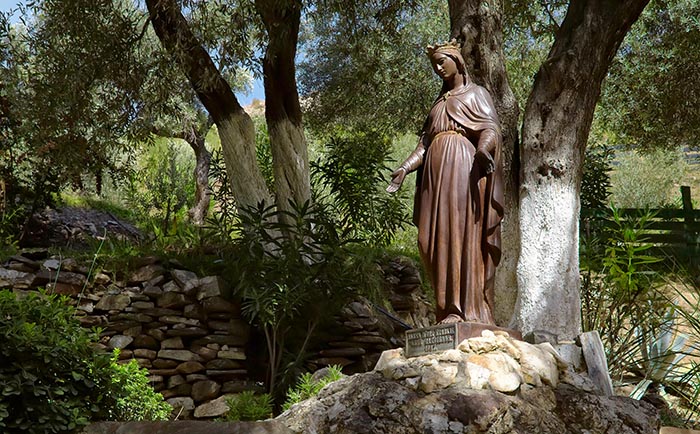
The statue of Mary amongst the olive groves in the grounds of her house. Photograph: MyerV/iStock
Rumi and Konya
.
After Seljuk, the way turned inland, cross-country to Konya. The distances between destinations meant there were long, arduous coach journeys but as these were laced with a sense of adventure and/or foreboding, they still made a kind of break for the students, for whom this was a field trip, not a vacation. En route there would be readings about the various sites that were about to be visited, which in early days came from the Blue Guide (3) but later developed from the knowledge gleaned by some of the frequent participants becoming familiarised with Greek history, Near Eastern mythology, archaeology and folklore.
There was also guidance on the spiritual meaning of the journey: in the notes on Rumi, for instance, students found the words:
It cannot be said that one goes to the tomb of a dead person. There is no death for the man who has realised union. He ‘died’ before death, and it is to his living presence that this journey is made.
… and the story of a man who went every year to Konya for the celebration of the nuptial night:
Someone said to him: ‘You come every year, you must love Rumi very much’, to which the man replied that he did not love Rumi as such, but he was in love with that which Rumi loved, and what he loves, loves Rumi.
In Konya, in accordance with Rumi’s own stated preference, the trip always went first to the tomb of Sadruddin Konevi, Ibn ʿArabi’s spiritual heir and Rumi’s great friend; then to that of Shamsi Tabriz before approaching the mausoleum of Mevlana himself, paying respects in each place to the knowledge, teaching and dynasty of the person. In the evening of the 17th December we attended the sema – the ‘turning’ of the Mevlevi dervishes. Semaʾ means listening – hearing – and the ‘performance’ is dhikr – remembrance of God. It is a beautiful action of self-awareness, adoration and praise. (For more on this, see the video Turning, made by Diane Cilento with Bulent Rauf, right or below.)
Video: Turning. Duration: 47:29
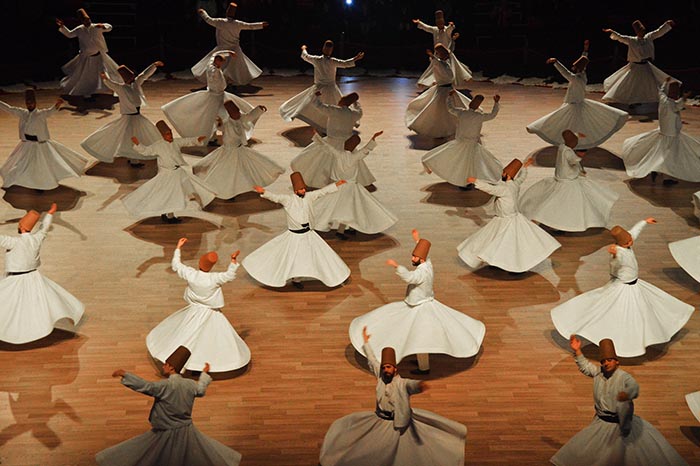
The Sema’, the ceremony of the Mevlevi dervishes in Konya, which for many years was only permitted for three days in December around the anniversary of Rumi’s death. Photograph: Serdar Başak [/] / Alamy Stock Photo
Taking place in the basketball arena set aside for the ‘illegal’ Sufi ceremony that could not be enacted in the Mevlevi Tekke – even this performance was only allowed for the three days in December – the government officials and politicians one after another made the most they could of the occasion with endless speeches that paid homage to Rumi, undoubtedly a giant among men. But there is a mystery about the ‘place’ where a person of great spirit may (or may not) have lived, and what it means to visit it. Meaning needs context to place it in the space–time continuum, but equally context needs meaning, an understanding of what gives life and spirit to things, and this is without limits through the mercy that is life’s gift, free from all constraints.
A Vision of Mary
.
Since these early trips, I have visited the Meryam Anna Evi many times, in spring and summer as well as in winter. One day I sat in the courtyard outside the house in the garden of the bulbul, looking towards the small, entrance door making a watercolour sketch, when an idea, vision, or revelation came to mind of a figure, a woman, not unlike a painting I had seen by Raphael, with a child in her care but now standing in the doorway of that humble little house. The dark doorway was in the shape of a figure, and the figure was Mary.
I included it in the otherwise observed scene as it is reproduced here. Trees have been cut down since then, concrete poured around the well and visitor centres constructed, but to my mind the soul of Mary’s House is there on a hill where the nightingales sing, where olive trees and fig trees grow and where water springs from the mountain – a mercy to all, whether they be visitors or just those who look to Mary for comfort from far or near.

Watercolour by Simon Blackwood
Gallery of Paintings
Click on a painting to start the full-page gallery slider.
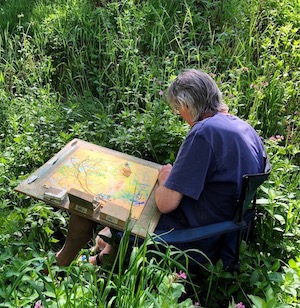
Simon Blackwood is an artist and picture restorer living and working in the Scottish Borders. He and Laura Blackwood, his artist wife, have lived in the same 17th century cottage for almost 40 years, creating a rich woodland garden from which Simon often draws inspiration. A significant part of his work has also been inspired by his time living and working in France and Istanbul, and his travels through Europe. To see more of his work, see his website www.simonblackwood.com
From the 1970s Simon attended the Academy for Continuous Education run by J.G.Bennett in Gloucestershire. From then he was involved in various projects promoted by the Beshara Trust, including the inception of the Industrial Buildings Preservation Trust and the Beshara Design Centre in London’s Docklands, notably documented as being 15 – 20 years ahead of its time. He also attended Beshara courses at Sherborne House and Chisholme House, and was a member of staff at the Beshara School of Intensive Esoteric Education at Sherborne House.
He writes about his work as an artist:
I do not follow any artistic religion or creed. My feeling is that creativity is outside time and of the moment. For me, the process of painting is like writing a music score or cooking a meal, but without preconceptions or recipes.
Painting or drawing from life is about being totally present in the moment you are making it – what it becomes then tells its own story. Colour is the magical ingredient and spontaneity the key that unlocks unexpected relationships.
Image Sources (click to close)
Banner: Mary’s House on the mountainside just outside Seljuk, Turkey. Photograph: Gelia/iStock.
Other Sources (click to open)
[1] ANNE CATHERINE EMMERICH, The Dolorous Passion of Our Lord Jesus Christ (latest edition: Jazzybee Verlag, 2015).
[2] See New Testament, John 19:26–27.
[3] See BERNARD MCDONAGH, Blue Guide:Turkey (Blue Guide, 3rd revised edition, 2001)
FOLLOW AND LIKE US
——————————————
——————————————
——————————————
Video: Turning. Duration: 47:29
FOLLOW AND LIKE US
If you enjoyed reading this article
Please leave a comment below.
Please also consider making a donation to support the work of Beshara Magazine. The magazine relies entirely on voluntary support. Donations received through this website go towards editorial expenses, eg. image rights, travel expenses, and website maintenance and development costs.
READ MORE IN BESHARA MAGAZINE
Rumi: The Operation of Divine Love
Alan Williams tells us about his new translation of Rumi’s great epic poem, the Masnavi
Mary, Seat of Wisdom and Mercy
Jane Townes explores the imagery of the Virgin Mary in the stained glass of Chartres Cathedral
Bewildered by Love and Longing
Michael Sells and Simone Fattal talk about a new translation of Ibn ‘Arabi’s famous cycle of love poems ‘Translation of Desires’
A Thing of Beauty…
The Sokollu Mehmet Pasha Mosque in Istanbul. David Apthorpe extols the exquisite combination of geometry and interior decoration in Sinan’s minor masterpiece.
READERS’ COMMENTS

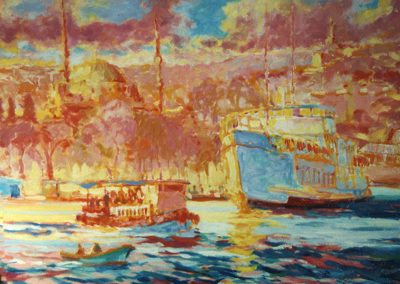

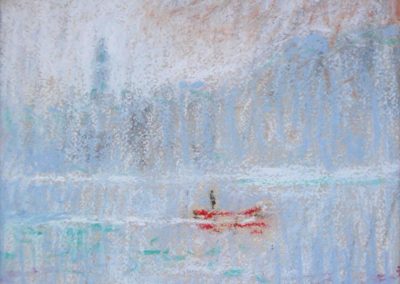
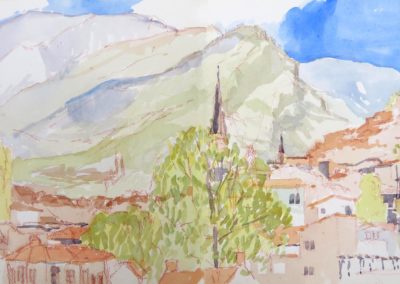
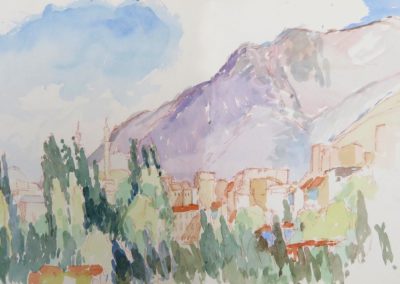
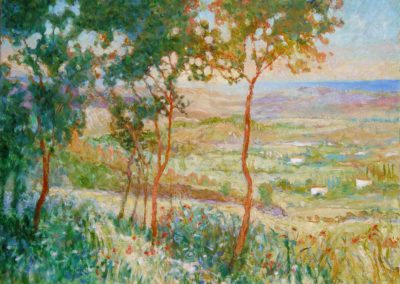

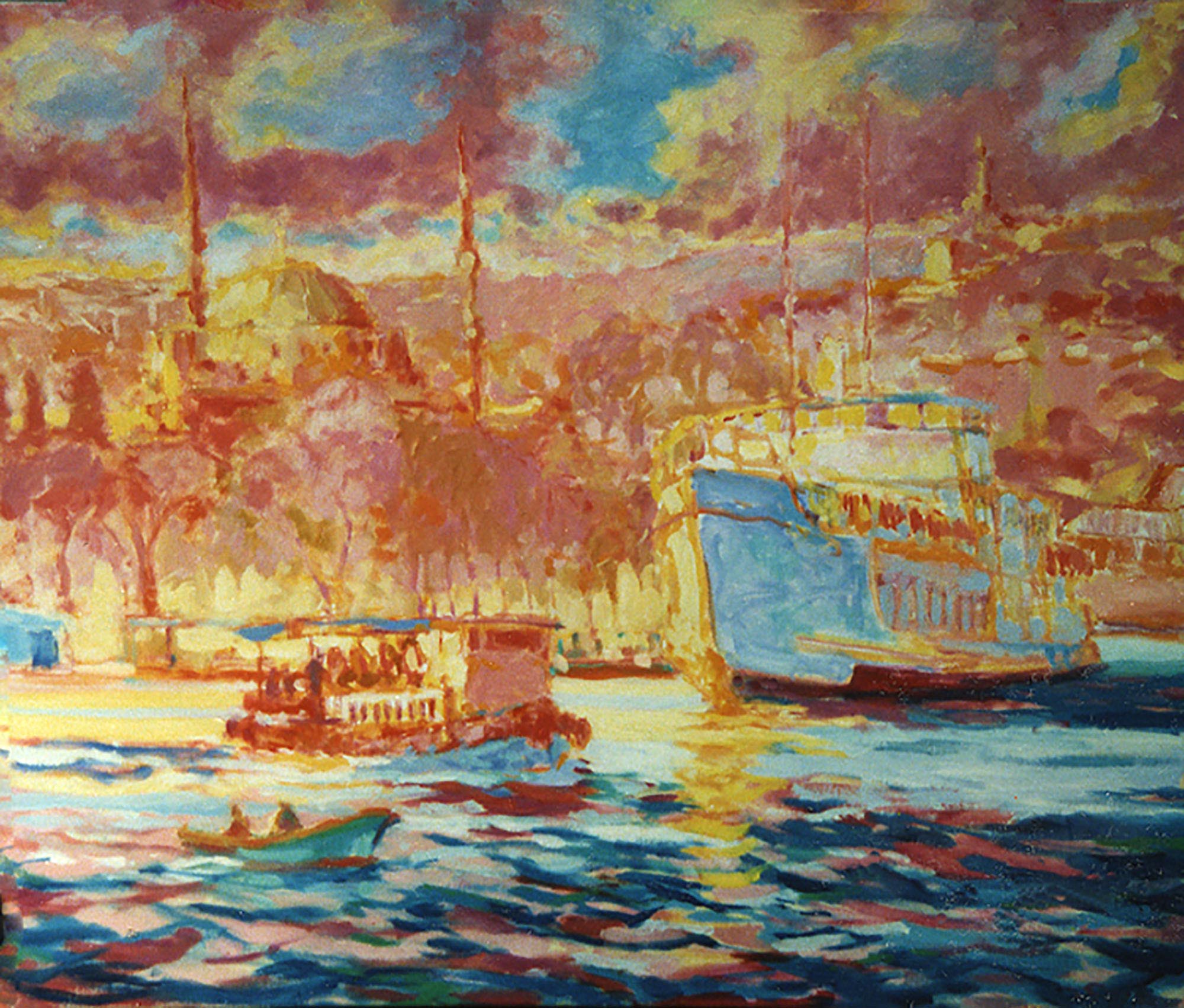

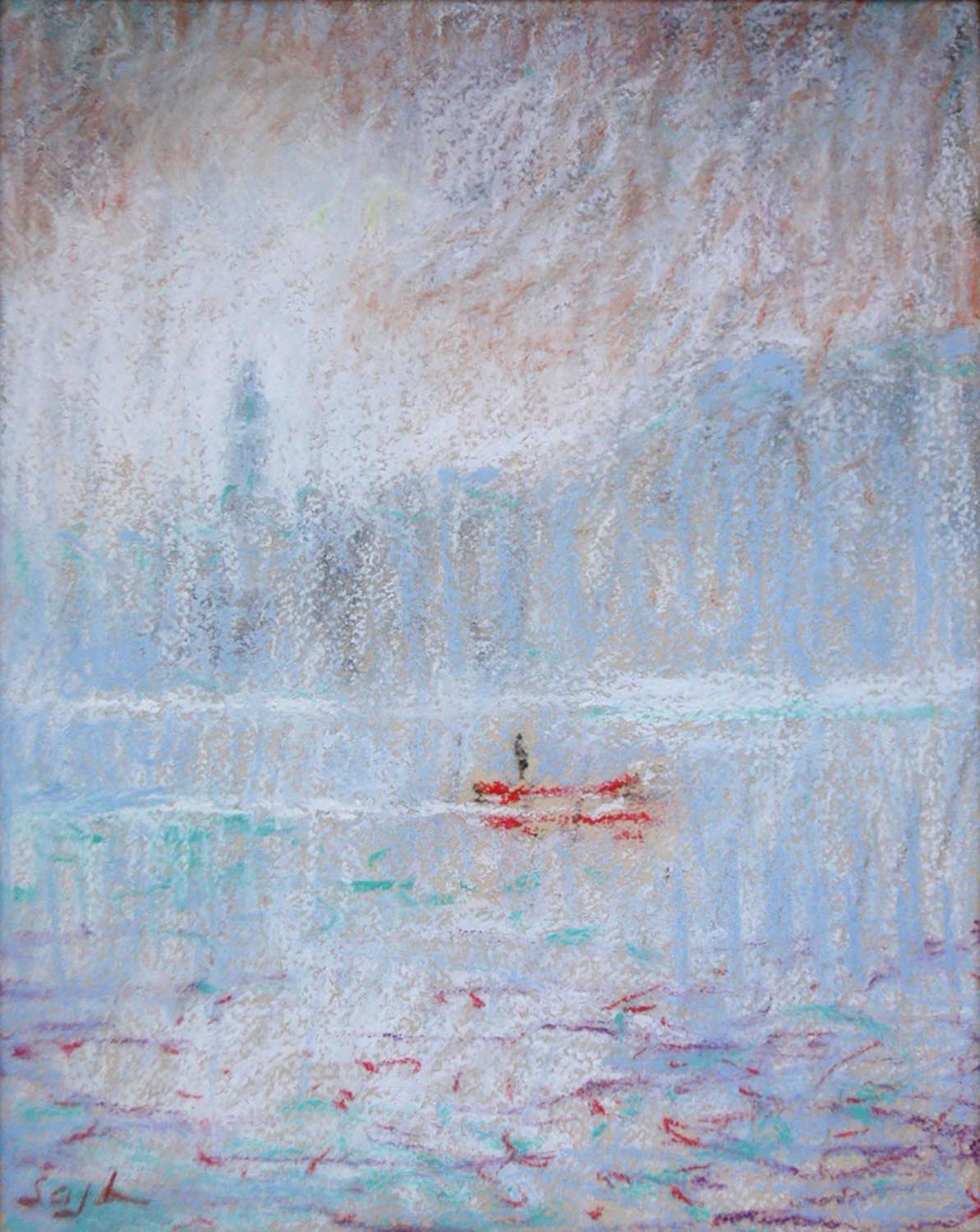



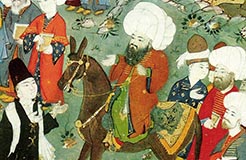



The most beautiful, lyrical description of remembered journeys. I feel so privileged to have been on some of them.
Metaphor is the bridge to Reality as spontaneity turns.. into serendipity
Why would you even talk about or mention this site where some believe Mary’s entombed and where she spent some time before death, if you are going to then state that the house there now is not from that time or era?
Since you are stating the building or house was constructed AFTER her death then it has not significance or importance whatsoever historically.
Also, you only mention this as being her home possibly but you failed to actually show the tomb of Mary Anna which i know from other websites exists and there are photos of it…..